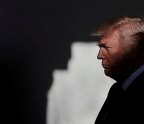The Counteroffensive

Photographs by Paolo Pellegrin
This article was featured in One Story to Read Today, a newsletter in which our editors recommend a single must-read from The Atlantic, Monday through Friday. Sign up for it here.
In March 1774, Prince Grigory Potemkin, the favorite general and sometime lover of Catherine the Great, took control of the anarchic southern frontier of her empire, a region previously ruled by the Mongol Khans, the Cossack hosts, and the Ottoman Turks, among others. As viceroy, Potemkin waged war and founded cities, among them Kherson, the first home of Russia’s Black Sea Fleet. In 1783, he annexed Crimea and became an avatar of imperial glory. To Vladimir Putin in particular, Potemkin is the Russian nationalist who subdued territory now impudently and illegitimately claimed by Ukraine, a nation that Putin believes does not exist.
The rest of the world remembers Potemkin differently, for something that we would now call a disinformation campaign. In 1787, Catherine paid a six-month visit to Crimea and the land then known as New Russia. The story goes that Potemkin built fake villages along her route, populated with fake villagers exuding fake prosperity. These villages probably never existed, but the story has endured for a reason: The sycophantic courtier, creating false images for the empress, is a figure we know from other times and other places. The tale also evokes something we recognize to be true, not just of imperial Russia but of Putin’s Russia, where mind-boggling efforts are made to please the leader—efforts that these days include telling him he is winning a war that he is most definitely not winning.
In a bid to restore Potemkin’s cities to Russian suzerainty, Russia occupied Kherson in early March of 2022, at the outset of a campaign to annihilate both Ukraine and the idea of Ukraine. Russian soldiers kidnapped the mayor, tortured city employees, murdered civilians, and stole children. In September, Putin held a ceremony in the Kremlin declaring Kherson and other occupied territories to be part of Russia. But Kherson did not become Russia. Partisans fought back inside the city, with car bombs and sabotage. Even as the occupiers held a ludicrous referendum, designed to show that Ukrainians had chosen Russia, the Russian army was quietly preparing to flee. By October, this new Potemkin village was collapsing, and the resurgent Ukrainian army was approaching the outskirts of Kherson. It was then that the Russians did something particularly strange: They kidnapped the bones of Grigory Potemkin.
Potemkin died in 1791. His skull and at least several other bones—which ones, exactly, is a mystery—were eventually brought to St. Catherine’s Cathedral, in Kherson, built by Potemkin himself. The bones were kept in a crypt beneath the cathedral nave. On a cloudy Sunday this past March, we visited the cathedral, which sits just a few streets away from the Dnipro River—now the front line—to try to understand why the Russian army, in the chaotic final days of its occupation of Kherson, had paused to rob a grave.
We arrived during a short break between services. The worshippers were mainly elderly, with a few younger people, even children, mixed in. The streets outside were empty; the city has been depopulated by the invasion, by the counterinvasion, and by ongoing, erratic fire from Russian soldiers, known to the Ukrainians as “Rashists” or “orcs.” On one of the days we visited, a missile hit a supermarket parking lot. Three people were killed in this attack, and three people wounded, including an elderly woman. The shelling sounded far away to us, except when it didn’t.
At the cathedral, a young priest rolled back a rug in the nave and opened a trapdoor. We descended narrow stairs. Potemkin’s bones once rested in a wooden coffin on a stone platform at the center of the dark, claustrophobic room. Father Vitaly—who spoke
You’re reading a preview, subscribe to read more.
Start your free 30 days





